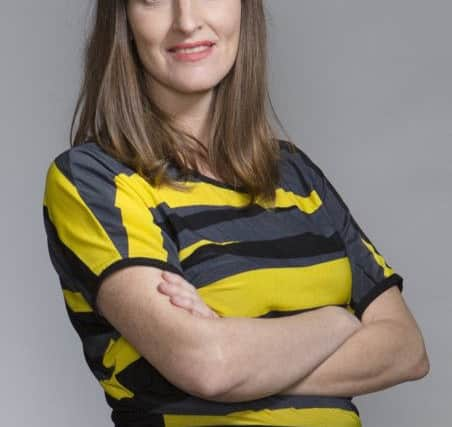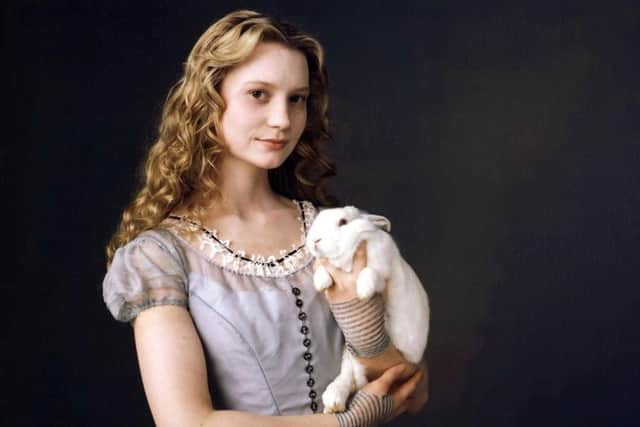Insight: The enduring charm of Alice in Wonderland


IT IS often claimed that listening to other people relate their dreams is tedious. It is also accepted among students of creative writing that to end a story with a character waking up and realising it was all a dream is the worst sort of authorial cop-out. And yet one of the most read and reread, adapted and analysed, referenced and ripped-off and generally obsessed-about works in the English language – or any of the 100-plus other tongues into which it has been translated – is presented as the dream of a character, and reads like the dream of the writer, even if no-one ever remembered a dream in the sort of vivid detail that characterises Alice’s Adventures In Wonderland.
Charles Lutwidge Dodgson’s novel, first conceived as an entertainment for a colleague’s young daughters, was first published in 1865, under the pseudonym Lewis Carroll. Its sequel, Through The Looking-Glass, And What Alice Found There, followed in 1871. If most fantasy novels, however beloved and influential, tend to obsess only a devoted handful in every generation that reads them, fascination with Alice has proved a far more pervasive phenomenon.
Advertisement
Hide AdCarroll’s vision of a small girl pitting her wits against the wayward worldviews of an array of unsettling anthropomorphic creatures and objects has intrigued mathematicians, philosophers, filmmakers and psychoanalysts, as well as innumerable children. Alice’s adventures have been reinvented as mainstream Disney fare; as steampunk graphic novels; as computer games, pop songs and pornography. You can also, if you choose, play them as a game of chess. Tim Burton’s 2010 film of Alice In Wonderland, which imagined Alice revisiting the site of her childhood adventures as a young woman on the cusp of marriage, became one of Disney’s highest-grossing films; his take on Through The Looking-Glass will follow next year. Marking the 150th anniversary of the first book’s publication, the Victoria and Albert Museum of Childhood is currently showing a major exhibition, The Alice Look, which explores the influence of the works and their illustrations on art, design and fashion; while Robert Douglas-Fairhurst’s new book The Story Of Alice explores the origins of Carroll’s tale and his relationship with the girl who was part of its first audience and lent its protagonist her name, Alice Liddell. The world of Alice is a dream from which we show no signs of waking up. Why the enduring preoccupation, and the ever-lengthening cultural shadow?


“What fascinates me about the Alice books,” says Fairhurst, “is that they are stories about growing up – about the world of childhood as a mysterious place we leave behind when we become adults – but they have themselves grown up with us over the past 150 years. They are like funfair mirrors which have reflected everything from the suffragette movement to drug culture. In reading them we are not only reading about Alice; we are reading about ourselves.” Such is the peculiar evocativeness of Carroll’s strange little set-pieces – so specific to his heroine’s experience, and yet so receptive to symbolic interpretations – that every generation that reads the books can bring to them its own set of meanings; while artists find them inexhaustible wells of inspiration.
Fairhurst, as Carroll did, teaches at Oxford University – the former is a Professor of English at Magdalen College; the latter taught maths at Christ Church – and he notes the way in which the specifics of that rarefied academic environment helped shape the text. “To outsiders, Oxford can seem like a bizarre and bewildering place,” says Fairhurst. “Of course Carroll was an insider – but what he created in Wonderland was a version of Victorian Oxford as seen through a child’s eyes: a place full of strange personalities and crazy rules, in which the only sane person turns out to be the one who has dreamed it up.”
Oxford isn’t the only real-world locale with Wonderland resonance, however. The notion that the Alice books reveal different significances to different readers is backed up by Bryan Talbot, the comic book illustrator and writer known as the father of the British graphic novel. Talbot wove his 2007 book Alice In Sunderland around connections between Carroll and the north-east of England.
“I’d been wanting to do something – I didn’t know what – based on Alice for about 20 years,” Talbot explains. “I wasn’t interested in writing a straightforward retelling of the story, but something original based around it and Carroll and Alice Liddell. When I moved to Sunderland about 18 years ago, I very quickly discovered that the city had many links with both Carroll and the Liddells and, in fact, parts of Alice were written here. The more that I looked into it, the more obvious it became that the Alice books are very firmly rooted in the north-east. That was, I realised, what my book had to be about.”


As a graphic artist, Talbot also recognises the significance of Sir John Tenniel’s illustrations to Alice’s cultural legacy. Though other illustrators – including Carroll himself, Arthur Rackham, Mervyn Peake, Ralph Steadman and Tove Jansson – have drawn their versions of Wonderland, Tenniel’s richly detailed black-and-white drawings remain definitive. “The Tenniel illustrations and the text of the books work in a similar way to text and illustration work in the comic medium,” says Talbot, “in that they blend together in the mind of the reader to make a whole, one that’s bigger than the sum of its parts. For example, Carroll never describes the Mad Hatter: our image of him is pure Tenniel.”
Advertisement
Hide AdAnother creator who has striven to capture the weirdness and profundity of Wonderland in another medium is Laurie Sansom, artistic director of the National Theatre of Scotland – although, in fact, his preference is for Through The Looking-Glass and its “topsy-turvy world of doubles and reflections”. Having staged three productions based on Carroll’s texts, Sansom declares himself “slightly obsessed”. It’s the language play and the ambiguity of the second book that have proved particularly lingering and suggestive to him. “Wonderland may be a crazy dream,” he says, “but Looking-Glass Land reveals some very sophisticated and disturbing truths about how the world works.”
One might not expect classic children’s books to be referred to as “disturbing” quite so often as the Alice books are. It’s not a word that tends to crop up in discussion of Little Women, say, or The Secret Garden (although those Water Babies were definitely pretty weird). For many readers, what lurks in the memory is not so much charm or magic as the unpleasantness of some of Alice’s experiences, the seasick logic of the conversations to which she’s subjected and the general sense Carroll creates of a world that’s often lonely, always unpredictable and occasionally downright cruel.
Advertisement
Hide AdWriter Vanessa Tait found Alice’s odyssey “discombobulating” as a child reader. “I hated Alice’s long neck,” she says, referring to one of Tenniel’s famous illustrations. “Also all the allusions to animals eating each other, and the constant threat of violence from the Queen of Hearts… Wonderland seemed a very scary place to be.” Tait has had more reason than most to feel haunted by Alice In Wonderland, for Alice Liddell, Lewis Carroll’s “child-friend” and muse, was her great-grandmother. “She’s always been part of my story,” explains Tait, who bears the middle name Alice. “I looked like her, especially as a child, when I was often asked to dress up as in the famous photo of her as a beggar maid; or to put on Victorian garb and read a copy of the book for the camera… But I was not nearly as alluring as Alice was. I was self-conscious. And I was always being asked which part of the book I liked best, when the answer was none!”


These days, Tait describes herself as “incredibly proud” of her link to the real Alice. Her first novel, The Looking Glass House, to be published in July, draws on family mythology and letters to portray her own version of the friendship between Carroll and Alice, seen through the eyes of a governess to the Liddell family.
For some, of course, that friendship between child and adult is grounds for suspicion. True to the strange capacity of the Alice books to draw out shared fears and foreshadow contemporary preoccupations, discomfort regarding the nature of Carroll’s interest in Alice now troubles the Alice legacy. Certainly Carroll idolised little girls, and loved to photograph them; “A girl of about 12 is my ideal beauty of form,” he once wrote. And as Fairhurst’s book explores, before Alice In Wonderland was even published there was a schism between Carroll and the Liddell family, which may have pertained to his premature and ill-received bid for Alice’s hand in marriage.
To Fairhurst, matters are a little more mysterious than modern labels might allow. “It may not be fashionable any longer to think of Rev Charles Dodgson and Lewis Carroll as two different personalities, like a real-life Tweedledum and Tweedledee,” Fairhurst says, “but that is certainly how he liked to present himself to the world. Inevitably that has led many people to speculate that he was hiding a dark and dreadful secret; but if so, it was such a good secret even he doesn’t seem to have been in on it.”
If circumstances off the page may have been tainted by an undue attachment, Alice the character is no creepy-cute poppet or sentimentalised ideal. Her practicality, her affected wisdom about the world and its ways and her occasional bouts of vulnerability make her one of the most skilfully drawn child characters in literature, while her tenacity in solving her own and others’ problems make her a winning role model – as well as the forerunner of every level-hopping, point-gathering protagonist in computer game history. “Alice was an anomalous heroine of her time, defined by an intense curiosity and assertiveness rather than conforming to the 19th century paradigms of angelic goodness,” says Dr Padmini Ray Murray, who lectures in publishing and digital media.
“She stands up to adults with gumption, navigates the unknown with fearless flair and thinks her way out of situations, something that little girls weren’t (and often still aren’t!) encouraged to do.” Certainly Alice is not one to be seen and not heard – and perhaps it’s her drive, intelligence and curiosity, even as things get “curiouser and curiouser”, that have worked most effectively for the books’ longevity.
Advertisement
Hide Ad“She’s a fantastic template for the sort of female character we still don’t see enough of,” says Murray, “and proof that if you’re brave and have your wits about you, fabulous adventures await!” «
Twitter: @HannahJMcGill
• The Story Of Alice by Robert Douglas-Fairhurst is published by Harvill Secker. Alice In Sunderland by Bryan Talbot is published by Jonathan Cape. The Looking Glass House by Vanessa Tait is published on 2 July by Corvus